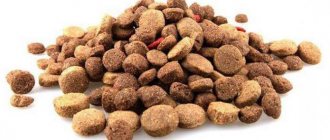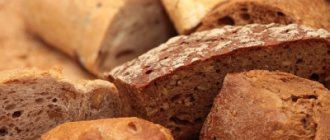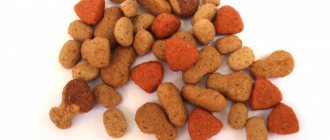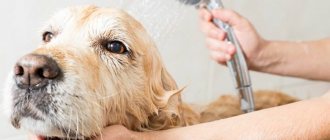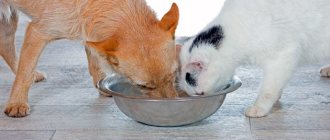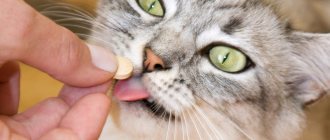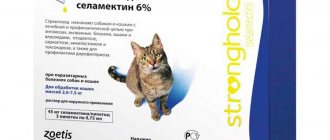Dogs need salt. More precisely, the elements of which it consists: sodium and chlorine. Their deficiency is just as harmful and dangerous as their excess. In any book on dog breeding, you can see that salt is an integral part of the diet, and a biochemistry textbook confirms the important role of sodium and chlorine in various metabolic processes. So why is salt taboo for many?
Salt is a source of important microelements
The importance of sodium and chlorine for the body
There are a lot of printed and electronic publications that write that dogs should not be salted in their food. But scientists and practicing veterinarians have a completely different opinion on this matter. Professor of the Department of Feeding of the St. Petersburg Veterinary Academy, Doctor of Agricultural Sciences Khokhrin S.N. in his book “Feeding Dogs,” he notes that due to a lack of salt in the diet, appetite, secretion of gastric juice, protein absorption are reduced, and growth retardation of young animals is observed. Chlorine and sodium are essential for life.
Sodium:
- Normalizes osmotic pressure;
- Conducts nerve impulses;
- Regulates acid-base balance;
- Participates in the synthesis of enzymes;
- Is a glucose conductor;
- Enhances the effect of adrenaline;
Chlorine:
- Participates in the synthesis of hydrochloric acid and amylase;
- Helps maintain joint flexibility and muscle elasticity, which is especially important for dog athletes;
- Promotes the breakdown and removal of toxins from cells;
- Necessary for the normal functioning of the circulatory system.
Daily dose
Salt is a natural flavor enhancer. Many dogs refuse unsalted food but will happily eat a seasoned portion. Therefore, from puppyhood, animals must be taught proper nutrition.
The daily dose is 0.0001 grams per 15 kg of live weight. It is impossible to accurately calculate it at home. Therefore, veterinarians recommend salting the dog’s food in such an amount that its taste is not felt on the tongue.
Salt absorption occurs in the small intestine, and the kidneys, sweat glands, and intestines take part in the process of its elimination. If the functioning of any of these organs weakens, it is necessary to transfer the dog to a salt-free diet.
Remember, there are foods that already contain salt. These include raw meat, lard, buckwheat, cottage cheese, kefir, and parsley. Salt is used in the production of pasta, semi-finished products, canned food, and sausages.
There is an opinion that dogs do not need salt in their daily meals, but once a week you need to give your pet a piece of pickled cucumber, fish, or sausage. Veterinarians recommend not to go to extremes, as this can cause a deterioration in the animal’s well-being.
Lack of salt in the diet: consequences
In the practice of veterinarians, teenage dogs with anomalies of bone development are increasingly appearing. Clinically, the picture is similar to rickets, but does not respond to appropriate treatment. It is not always clear in time that the whole point is the absolute absence of salt in the diet with a good natural diet. Puppies exhibit characteristic curvature of the forearms and poor joint mobility. They get tired quickly and move little. After 6 months, this process is irreversible; the dog remains disabled for life.
Lack of salt in the natural diet can be dangerous
How do you know if there is too much salt?
Salt retains and absorbs water, that is, a dog whose tissues have accumulated sodium will drink a lot . The pet will feel thirsty regardless of the air temperature. The natural consequence is increased urination. The color of the urine will be lighter than usual. The changes occur because the dog's kidneys work faster, trying to eliminate as much salt as possible in a short time.
How much salt does a dog need?
Sodium is found in most foods of animal and plant origin. Fish, eggs, buckwheat, rice and other cereals that can be given to dogs are rich in chlorine. But food cannot always fully provide the body with important macroelements. And it’s rare that a dog receives a perfectly balanced diet. In addition, some macroelements (25-60%) leave with water during cooking.
According to Professor Khokhrin’s calculations, to satisfy dogs’ need for salt, in addition to that contained in raw foods, you need to add:
- 530 mg/kg body weight for puppies;
- 220 mg/kg body weight for adult dogs.
This norm does not take into account the additional introduction into the diet of foods rich in salt, which owners love to pamper their pets with. For example, 100 grams of semi-hard “Russian” cheese contains approximately 800 mg of salt; in rye bread - 430 mg; in Cervelat sausage - 2225 mg; and in pork sausages there are about 900 mg. Ready-made dishes from the host’s table also contain a lot of salt: soups, borscht, cutlets, sauerkraut, dumplings, etc.
An adult dog weighing 5 kg only needs to eat 50 g of Cervelat to get the daily salt requirement.
The dog needs to add salt to unleavened porridge with meat and vegetables when it is prepared separately for it and not fed from the table. In other cases, it is better to carry out individual calculations.
What salt is best to give to a dog?
The best option would be purified (edible) sea salt. In addition to sodium and chlorine, it contains a complex of bioactive micro- and macroelements.
The recommended amount of salt is practically not felt in food
Can dogs salt their food on a natural diet?
Another thing is that a pet cannot consume raw meat every day; not all dog breeders have the means to purchase such products. If this is meat sold on an industrial scale in stores, then in most cases it contains salt.
Can dogs salt their food on a natural diet?
- Many sellers soak meat in salt water to increase its weight. Accordingly, there is no need to introduce additional salt in this case. If the meat was bought secondhand from a farmer you know, then it is necessary to add salt to such food.
- Let us give an example: in all Soviet nurseries, dogs were fed with the introduction of salt. When preparing food, it was added in an amount of half of the norm that people administer to themselves. All dogs grew up healthy and strong.
- Accordingly, a small amount of salt is still acceptable. Under no circumstances add enough salt to yourself. Introduce sodium chloride in small amounts so that it is barely noticeable in taste.
Cutlets for dogs
If the dog eats ready-made food
Almost all industrial feeds contain salt or other substances that are sources of sodium and chlorine for the body. Therefore, additionally including it in the diet or feeding the dog salty foods is dangerous. The amount of nutrients in feed is strictly calculated and is optimal.
If a dog regularly eats more than the portion indicated on the package, the body may be oversaturated with macro- and microelements, and if it also eats from the table, it is not far from poisoning.
If the dog eats industrial food, additional salt is not required.
Industrial feeds contain the required amount of sodium and chlorine
Preventive measures
In super-premium food, the manufacturer calculates the exact dosage of all nutrients, taking into account the breed of the dog. After all, toy terriers, Labradors and mastiffs require different nutrition, corresponding to the size and activity of the dog.
When preparing dishes from natural food products, veterinarians allow food to be slightly salted. However, salty biscuits, sausage, and canned vegetables are contraindicated for dogs.
Teach your pet from puppyhood not to eat without the owner's permission. Many foods that are considered delicacies for humans are harmful to animals. And there may be spoiled or even poisoned food on the ground.
Table salt poisoning
Salt poisoning is not always pronounced. Sodium and chlorine can accumulate in organs and tissues for a long time, having an almost imperceptible negative effect on the body and aggravating the course of other diseases.
Salt poisoning is not always caused by foods. In winter, the sidewalks are also sprinkled with salt in some places, and then the dog licks it off his paws. Animals living or visiting the sea coast are also at risk. It happens that after an active walk, dogs begin to drink sea water or poison themselves by licking their fur after bathing. Sometimes the owners themselves pour huge doses of salt on the root of the tongue to induce vomiting in the “old-fashioned” way.
Acute clinical poisoning manifests itself after 3-4 hours. Thirst increases, temperature rises, breathing quickens, salivation and vomiting, diarrhea mixed with blood are possible.
With excess salt, the level of sodium in the blood increases by 1.5-2 times, and in red blood cells by 3-5 times. It displaces potassium, which is necessary for the transfer of oxygen by hemoglobin, and hypoxia develops. Chlorine and sodium accumulate in all tissues and organs, which causes muscle tremors, cramps, and paralysis.
The disease can last from several hours to 2 days. In acute cases and rapid development of symptoms, the prognosis is unfavorable.
It has been established that a dose of 3-4 g/kg is lethal for carnivores. Against the background of mineral starvation, death can occur with less quantity.
Consequences of overdose
Sodium deficiency also negatively affects a dog's well-being. She becomes lethargic, weak, drowsy. When switched to a salt-free diet, pets lose interest in their favorite activities, refuse food and walks.
Scientists have concluded that salt and sugar act as a natural antidepressant. Salty and sweet dishes lift the mood and increase the activity of the animal.
Dehydration
A salt-free diet can lead to problems with fluid retention in the body.
Dehydration is manifested by deterioration of the coat and skin, weakness, and slow pulse.
The dog is thirsty and tries to drink from any container or puddle. The dog can be poisoned by harmful substances from dirty water. Dehydration is treated with Regidron; antibiotics (for example, benzylpenicillin) can also be added.
Hypertension
An excess of sodium in the blood leads to changes in its composition. Because of this, the entire cardiovascular system suffers, which is manifested by an increase in blood pressure. Symptoms of such a disease are tremors of the limbs, disorientation in space, dilated pupils, and nosebleeds. The treatment complex includes switching to a salt-free diet and taking medications.
Urolithiasis disease
If you uncontrollably salt the food of puppies and small breed dogs (lapdogs, Pekingese, Yorkies), stones will form in their bladder. Such dogs have a genetic predisposition to urolithiasis.
It manifests itself as pain when urinating, blood in the urine. For treatment, the animal is prescribed anti-inflammatory, painkillers, and diuretics.
Cystitis
Without timely treatment, urolithiasis can be complicated by concomitant diseases. Cystitis is most often diagnosed in pets. Its symptoms are frequent urination, pain in the perineum, and puddles of urine on the floor. To prevent the disease from becoming chronic, the animal needs anti-inflammatory and antibacterial therapy. The owner is prohibited from adding salt to the dogs' food until the excretory system is completely healed.
Treatment
Free access to water, drinking milk and mucous products that prevent the absorption of salt and promote its excretion. Glucose with caffeine is administered intravenously. Subcutaneous calcium gluconate. The dosage is calculated by the veterinarian based on the size of the dog, age and general condition.
First aid for salt poisoning
Sodium and chlorine are essential elements that enter the body only with food, and their main source is salt. Excess of it is very dangerous, so it is important to accurately calculate the daily intake. It is possible, and even necessary, to add salt to your dog's unleavened porridge with meat and vegetables, provided that the animal does not receive salt from other sources.
Symptoms of excess
Salt can be deadly to dogs. During the research, scientists found that fatal intoxication occurs when taking 3 grams per 1 kg of animal weight.
Even a little oversalting is harmful to your pet. It causes thirst that is difficult to quench.
The dog begins to drink a lot, which leads to edema. The animal empties its bladder frequently. But the urine comes out unnaturally light, since the kidneys do not have time to fully perform their functions.
The blood becomes thick, and it becomes more and more difficult for the heart to pump it through the vascular system. The situation is complicated by dysfunction in the hypothalamus due to deterioration of nerve conduction. As a result, the regulation of all biochemical processes in the dog’s body is disrupted.
